Just a few years ago, fungal nail diseases did not have much importance, while now everyone understands the need for timely detection and treatment of massive contagious fungal infection caused by various dermatophyte fungi. Thanks to widespread public awareness, the number of visits to specialists with this pathology has increased, which has led to an increase in the detection of foot fungus. Since any deformation of the nail plate for no apparent reason (e. g. injury) is primarily suspected of a fungal infection, self-diagnosis is a decisive factor in this case. So, any changes in the nail plate are a reason to contact a dermatologist, because at least half of these disorders will have a fungal etiology, and the rest will require careful diagnosis, also carried out by a specialist.
Factors leading to the appearance of fungus:
- In fact, fungal nail infection is a slow disease that does not lead to life-threatening conditions and does not cause pain or discomfort. It more often affects the elderly population, who often associate changes in appearance with the aging process.
- Patients themselves are often embarrassed by the disease, unprepared for the financial costs of treatment, or convinced that it is incurable. Many people begin self-medication and do not see the disease as a reason to consult a specialist.
- Since the disease mainly affects the feet, even during medical examinations or examinations by doctors, it usually does not come directly to the examination of the feet, without specific complaints from patients about changes in the nails. This is facilitated by the extremely short time allowed to see patients even in specialized institutions, which unfortunately forces doctors to examine them only for the main reason for the visit.
Fungal nail infection lasts quite a long timeTherefore, the earlier the disease is detected, the higher the probability of complete recovery. In addition, an early start of treatment allows us to limit ourselves to the use of external preparations and nail cleanings only, and this is possible only if the infection has affected isolated nails from the distal edges orsides of less than 1/3-1. /2 of the plate. Local external therapy is used to treat the early stages of fungal nail infection. Advanced forms of fungal infection require longer and more expensive treatment. Periodic preventive examinations and medical examinations of the population play a special role in the early detection of nail fungus.
Consequences
This seemingly harmless disease can lead to very serious complications:
- damage to smooth skin and secondary infection;
- fungal sensitization with the formation of allergic reactions and foci of microbial eczema;
- complication of chronic dermatoses, varicose veins of the lower limbs and foot lesions in diabetes mellitus, etc.
It is impossible not to mention the epidemiological importance of existing foci of fungal infection: a sick person will infect public places and other people, and in everyday life will be a source of intrafamily transmission of fungal infection.
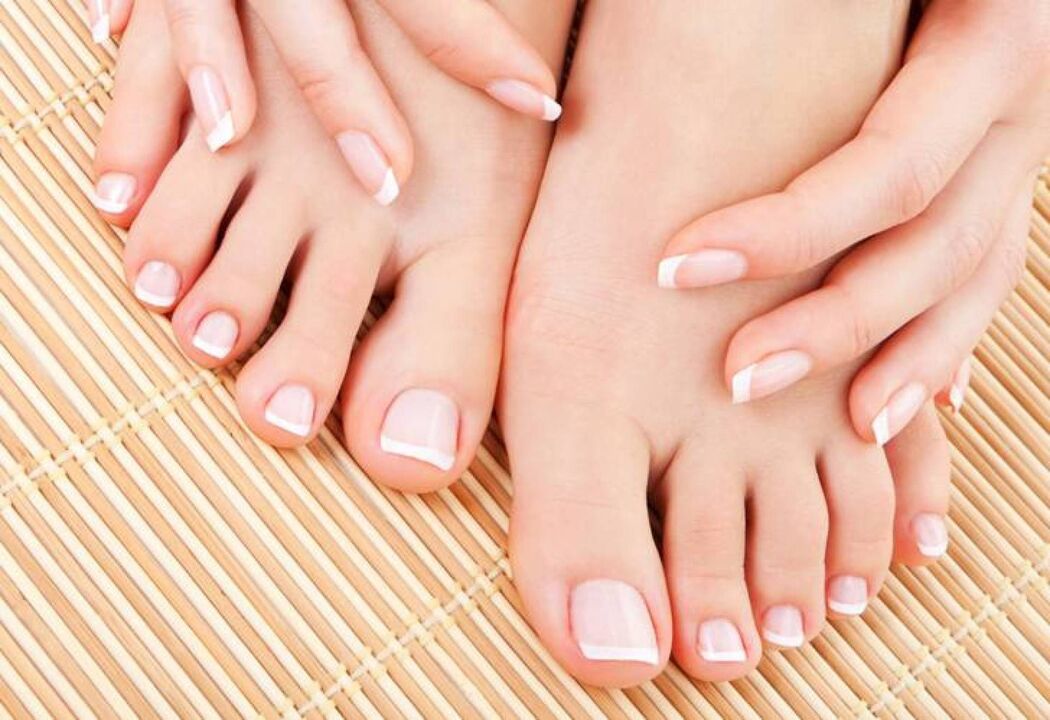
Nail fungus (medically called onychomycosis) is a fairly common disease. According to doctors, it affects more than 15% of the world's population, even if this pathology is diagnosed much less frequently (in 2% of people). This discrepancy is explained simply: nail fungus does not threaten life, and if it deteriorates its quality, in most cases it is very insignificant. Therefore, people do not always consult a doctor about onychomycosis, trying to cope with the disease on their own or simply leaving it without treatment.
Nail fungus develops quite slowly. Therefore, early signs of fungal infection usually escape the patient's attention. When changes in the nail caused by the fungus begin to be noticeable, this means that the process has already gone far enough and it will not be easy to defeat the fungus.
Onychomycosis is often seen as a cosmetic problem: nails affected by the fungus appear unsightly. But it is necessary to fight fungus not only to return the nails to their correct shape and shine. If the fungus is left untreated, it will spread further. Usually, the big toe nail is the first to be affected. If treatment is not started, the fungus spreads to the other toes and, as we inevitably touch our feet with our hands, it is possible that the toenails and toenails will subsequently become infected with the fungus. The fungus also spreads to the skin surrounding the nail, causing irritation and itching.
Causes of onychomycosis
Onychomycosis can be caused by different types of fungi. First of all, they are dermatophytes. Next come yeasts of the Candida genus, always present in small quantities on human skin (they most often affect the nails). Infection with mold is also possible (they usually accompany other pathogens. Isolated infection with mold is typical not for our climate, but for the tropical climate).
The risk of fungal infection increases with age. In children, nail fungus is very rare, and, conversely, in older people it is detected relatively often. Additionally, men suffer from onychomycosis more often than women.
The age specificity of the fungus is explained by the fact that our local immunity decreases over the years, while the natural defense of a young body usually suppresses the activity of fungi well, preventing them from colonizing the nail plate. There is a dependence not only on local immunity, but also on general immunity. A weakened general immune system constitutes a favorable context for the development of any fungal infection.
For fungi of the genus Candida, it is enough that there are problems with the immune system: they simply begin to actively reproduce. Fungi of other species still have to somehow penetrate our body from the external environment. Some types of fungi can be carried by animals. Mold is found everywhere; they are capable of reproducing without a host. However, in most cases, the fungal infection spreads from person to person.
Mushrooms like a humid environment. Therefore, fungal infections often occur in places with high humidity. These are swimming pools, saunas, changing rooms, gyms. Wearing socks and shoes on wet feet can also be a trigger.
If there are wounds and cracks, they allow the infection to penetrate directly into the tissues, thus avoiding the need to assault the protective barrier that forms the surface of our skin.
The spread of fungi is facilitated by negligence in personal hygiene: you should not use someone else's slippers, soap or towel. It is precisely because not all families follow this rule that nail fungus often becomes a family disease.
Damage to the nail usually begins at the edge. Dermatophytes penetrate under the free edge of the nail plate (into the subungual recess). In this case, the pathological process develops mainly in the nail bed. The second route of entry for fungi comes from the nail fold. The Candida fungus usually affects the posterior nail fold first (paronychia occurs), and only then the nail itself suffers. One type of dermatophyte (T. mentagrophytes) can penetrate directly through the nail plate.
Symptoms of onychomycosis
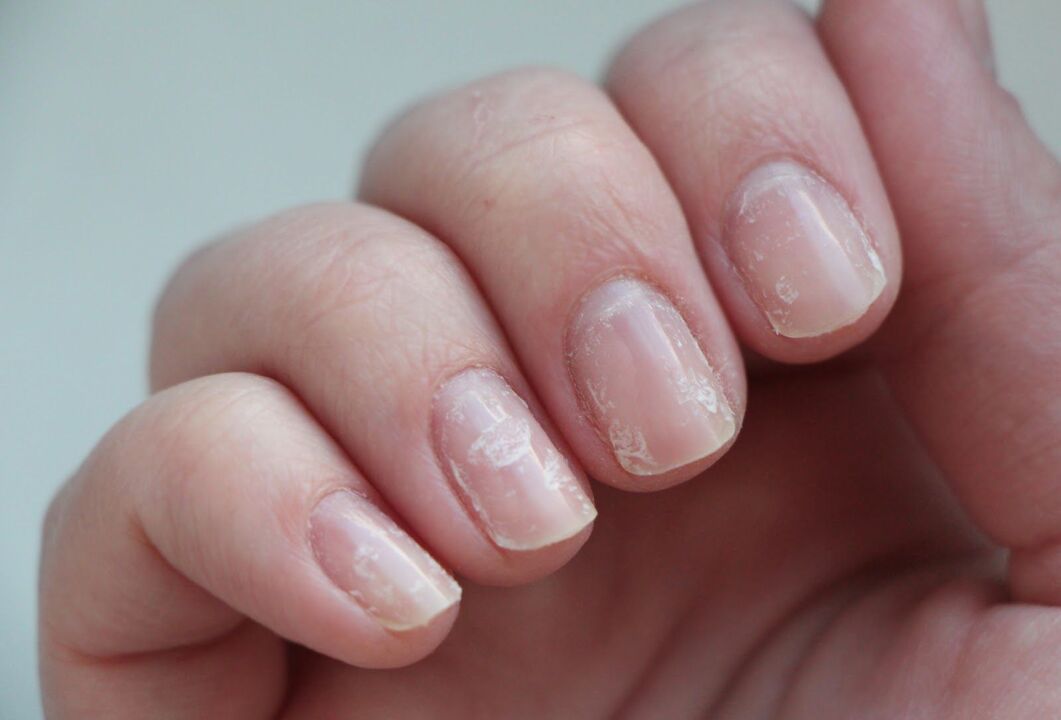
The first sign of a fungal infection is loss of shine of the nail, clouding and discoloration. In cases where the infection affects the skin around the nail, itching occurs. If treatment is not started, the fungus begins to destroy the nail plate: the surface of the nail becomes rough, the nail can flake, flake, break, crumble.
Specific manifestations depend on the pathogen, as well as on the location, duration of the pathological process and its form. There are normotrophic, hypertrophic and atrophic forms of fungal infection.
It is characterized by the fact that the thickness of the nail plate remains unchanged. The disease manifests itself in the form of white or yellowish spots, which gradually increase in size. Eventually, the color of the entire nail changes. The nail plate may become detached because the fusion of the nail with the subungual tissues is disrupted.
It is characterized by a significant increase in the thickness of the nail plate (due to the growth of the subungual epithelium). The nail turns yellowish-brown or gray. The nail plate usually actively crumbles. The nail is particularly damaged on the sides, giving it a claw-like shape.
With this form of fungal infection, the nail becomes thinner and destroyed from the outer edge. The destruction goes deeper, to the posterior fold of the nail; the nail bed is filled with a loose mass formed by decaying particles of the epithelium. Eventually, the nail may be lost completely.
Methods for diagnosing onychomycosis
Color changes and brittleness of the nails should be a reason to consult a dermatologist. You should not replace the doctor and diagnose yourself - you can be wrong: changes in the nail may have a different cause.
The doctor makes a diagnosis based on a visual examination (a microscope can be used). To confirm the diagnosis, laboratory diagnostics are carried out. It is also necessary to establish the type of pathogen (this will allow prescribing the most effective treatment).
During the appointment, the doctor will scrape the affected nail plate. If the pathological process has affected only the free edge of the nail, scraping of the subungual epithelium is also performed.
Microscopy is carried out in the laboratory. Cultural studies are also carried out (the material is placed in a favorable environment and we observe if a colony of fungi appears). Cultural studies help determine which fungi are causing the disease.
To accurately diagnose the disease, make an appointment with specialists from the family doctor network.
Methods for treating onychomycosis
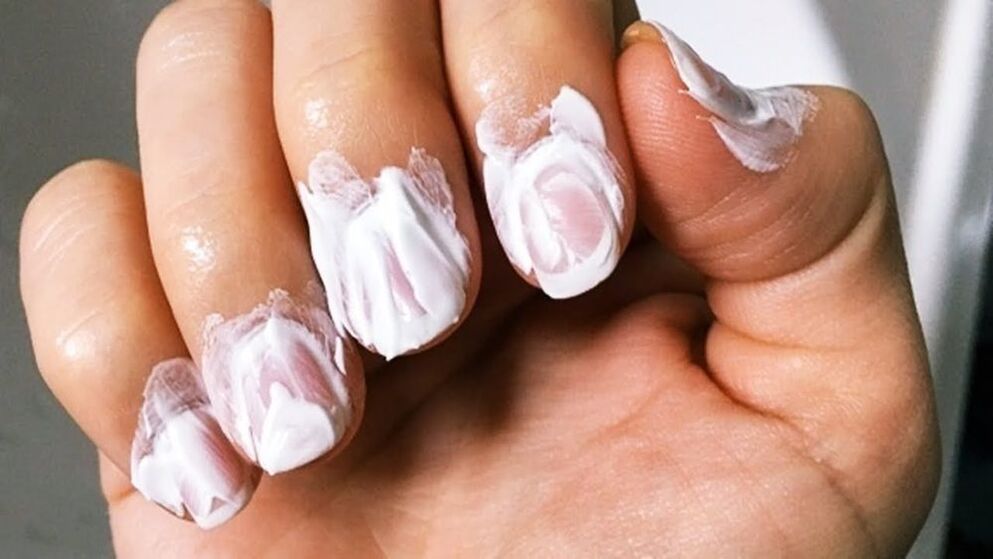
Treatment for nail fungus involves removing the affected part of the nail. Then treatment is carried out using local antifungal agents (ointments, drops, sprays, varnishes). For large lesions, the doctor may prescribe general antifungals (tablets).
Since fungal activity increases against the background of immune problems, the proposed treatment may include measures aimed at increasing overall immunity.
It is advisable to apply local products (ointments, creams, drops) to the open nail bed. Do not stop treating the affected area until the time prescribed by your doctor has expired. Before removing the treatment, the doctor will most likely do another scraping so that a laboratory test can confirm the absence of fungus. Otherwise, the risk of disease relapse is high.
Don't self-medicate. Contact our specialists who will correctly diagnose and prescribe treatment.
Recipes with vinegar to treat nail fungus
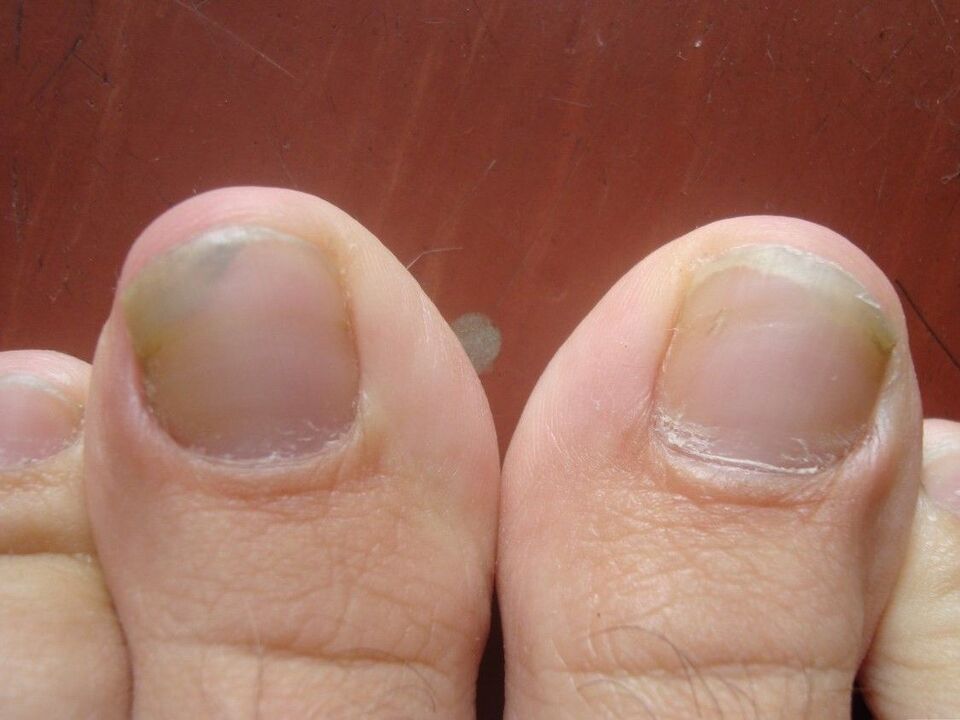
Having discovered toenail fungus, only a few decide to seek help from a specialist. Others often ignore the problem until it reaches an advanced stage. Given the high cost of drug treatment, more and more people are choosing folk remedies to eliminate unpleasant manifestations of the disease.
Treating nail fungus with vinegar is the easiest way to get rid of an unpleasant disease. Simple and affordable recipes, if used correctly, will help quickly cure an incipient infection. Vinegar and eggs provide significant help in the complex therapy of onychomycosis, as an addition to medications. The product is also used for prevention and rapid relief of unpleasant symptoms.
Reviews of the folk remedy for toenail fungus using vinegar essence and eggs are mostly positive. Many patients claim that with the help of this remedy they were able to cope with the disease in just 2-3 weeks. However, this effect can only be achieved if the onychomycosis is in an early form.
Causes and symptoms of fungus
Symptoms of the disease and photos:
- change in plaque thickness – thickening or thinning;
- Unpleasant smell;
- swelling, hyperemia, pain in the nail folds;
- the appearance of stripes or spots of different colors - white, yellow, black;
- delamination and destruction of the plate, deformation.
In later stages, the plates move away from the bed, become mobile, and severe pain is felt during movement. Warped plates make it difficult to wear shoes. For women, problems increase due to the inability to wear open sandals, as their appearance suffers. Onychomycosis is usually accompanied by a skin infection, in which the limbs itch, peel and the skin peels off. Vinegar essence, available in any home, can be a real salvation at the initial stage of treatment of nail fungus.
The agents responsible for onychomycosis are opportunistic: they are constantly present in close proximity to humans. What factors contribute to the development of the disease:
- decreased immunity;
- constant contact with a sick person and their belongings;
- wearing and using someone else's clothing and hygiene products - washcloths, slippers, manicure and pedicure accessories;
- ignore hygiene rules;
- increased sweating of the extremities;
- visiting beauty salons with bad antiseptics.
It is easy to become infected with onychomycosis. It will take a long time to cure nail fungus with vinegar, as well as any antifungal agent. Often, infection is detected when the pathogen has penetrated deep into the nail plates and their destruction is evident.
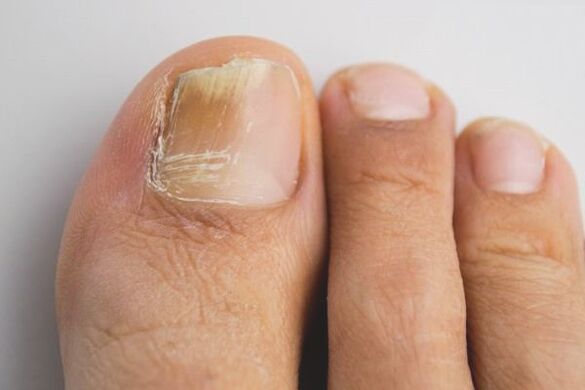
How does vinegar affect the source of disease?
The positive effect of treating nail fungus with acetic acid is created by its effect on pathogenic microorganisms. An acidic environment is detrimental to dermatophytes.
With prolonged contact with acid, the fungus stops multiplying and dies.
Ointment for treatment
An ointment that can quickly and effectively cure fungus can be prepared according to the following recipes:
- Take glycerin and 7 or 9% vinegar and mix everything together. The amount of components should be used so that a paste consistency is obtained. After that, the finished mixture is applied to the feet about 2 times a day.
- You need to take 1 egg and dip it in 70% vinegar essence. After waiting for the shell to dissolve, remove the film and mix the white and yolk with 200 g of butter. Before using the ointment, it is recommended to steam your feet well. It should be kept for up to 8 hours, so it is best to use the product at night.
You can prepare an ointment to treat nail fungus at home using one of the following recipes:
- Take equal parts glycerin, olive oil and dimethyl phthalate. Stir and add a double part of 70% vinegar essence to the resulting mixture and mix again. Apply to the nail and leave for 10 hours, then rinse with water and laundry soap;
- take 40 g of eucalyptus essential oil, 1 large spoon of 9% vinegar and 15 g of honey, mix everything and place in the refrigerator for 3 days. After that, the finished ointment should be applied once a day to the affected nail plate.
You can use vinegar for toenail fungus by cauterization. The main advantage of this method is that it requires a minimum of time and its effectiveness is comparable to other methods.
How to prepare the mixture? Traditionally, vinegar and iodine are mixed in equal parts and applied to all toenail plates. The amount of product applied depends on the size of your plate. Generally do not use more than 2 to 4 drops. Then you need to wait until the solution is absorbed and you can get dressed or, for example, go to bed. The procedure is carried out no more than 1-2 times a day.
What causes fungal infections?
Mushroomsspreading from the foot (called"dermatophyte mushrooms"), cause most fungal nail infections. More rarely, nail infections are caused by other types of fungi, usually yeasts (eg.Candidiasis) Andmold.
These fungi tend to attack already damaged nails because they penetrate more easily. Fungal infections of the toenails are very common (1 in 4 people may be affected at some time), while toenail fungus is less common. Both types are more common in older adults, people with weakened immune systems, and people with diabetes and poor peripheral circulation. A warm, humid environment encourages the growth of fungi and causes infections. Wearing tight shoes or using showers, toilets, or locker rooms can increase your risk of yeast infections.
Are they hereditary?
Absolutely not. However, in some extremely rare cases there is a genetic risk factor and other family members may also be affected.
What are the symptoms of fungal nail infections?
At first there are usually no symptoms. Later, the nails may thicken and become painful when pressure is applied inside the shoe. They are then difficult to cut. The sight of an infected nail, especially a toenail, can be embarrassing. The affected nail can damage socks and tights and can also rub adjacent skin. The surrounding skin may also have a fungal infection; it may itch, crack, blister, or appear whitish, especially between the toes.
What do nail fungus look like?
Fungal nail infectionusually start from its free edge, then extend along the side of the nail to the base of the cuticle. Eventually, the entire nail may be affected. Infected areas turn white or yellowish and thicken and flake. More rarely, white inclusions may appear on the surface of the nail. The nails most likely to be damaged by fungal infections are the big and little toes. Sometimes, especially in those who regularly do wet work, such as housewives or cleaners, the skin around the nail becomes red and swollen. This is called paronychia and can allow infection to easily enter the nail.
How is nail fungus diagnosed?
Fungal nail infectionsusually diagnosed clinically. Your doctor may take a piece of the infected nail and send it to a laboratory to see if the fungus can be seen under a microscope or grown in culture. Sometimes repeat samples may be necessary.
Many nail problems may only look likefungal infection, - for example, changes seen in psoriasis, after a bacterial infection or an old injury, but antifungal tablets will not help. Proper treatment may depend on knowing the fungus causing the problem; It may take several weeks to see results.
Can fungal nail infections be cured?
Yes. However, to succeedtreat a fungal nail infectionLong-term treatment is required, which can take up to a year. Nails are easier to treat.Fungal nail infectionsusually return, especially on the toes.
How to treat nail fungus?
Fungal nail infectionsare not worrisome in themselves and do not all require treatment. Some people with infected nails don't worry about it at all. In this case, they can sometimes be left alone (although the patient should remain careful and try not to spread the infection to other parts of the body and to the nails, or to other people).
On the other hand, ifinfected nailscause embarrassment or inconvenience, they are usually dealt with. It is important to treat people whose infections can lead to serious health problems, such as diabetes or a weakened immune system, to prevent potentially serious health problems.
The goal of treatment is to get rid of the fungus: the nail then generally returns to normal. However, if the nail was damaged before becoming infected, it will be more difficult to clean and may return to its previous state.Nail infectionscaused by molds and yeasts can be very resistant to treatment.
Treatment options include:
Treatments applied to the nails (local treatments)
Treatments applied to the nails do not work as well as treatments given by mouth. They are more effective if the infection is at an early stage. The most commonly used methods are amorolfine, ciclopirox, and tioconazole nail polish solution.
They may not be able to clean the deeper parts of the infected nail themselves, but regularly remove the damaged part of the nail using nail clippers or sandingcan help. Oral medications used in combination with an antifungal agent increase the chance of recovery. You may need to use them for 4 to 12 months before any effects are seen.
Forfingernail infectionsthe duration of treatment is shorter. The cure rate with local treatments alone is approximately 15 to 30%. Local treatment is safe. Redness and irritation may occur.
Before you start taking the pills, your doctor should send part of the nail to a laboratory to check for a confirmed diagnosis of fungal infection.
Laser and photodynamic therapy can be helpful but are less effective than the topical and systemic treatments listed above.
Herbal products are also promoted fortreat a fungal nail infection, but there is no convincing evidence that it is safe or more effective than standard treatments.
Surgical nail removal
Sometimes very thick nails that do not respond to pills alone can be removed by surgeons under local anesthesia, but this is rarely done because the level of result does not warrant surgery.
Self-care
- Keep nails short, dry and clean. Use one clipper for infected nails and the other for normal nails.
- Don't just treat your nails; Use an antifungal cream to treat the skin on your feet.
- Avoid cutting cuticles, either by yourself or by a nail technician, as this increases the risk of nail damage and infection.
For fungal infections of the toes:
- Wear comfortable shoes without high heels or tight socks.
- Keep your feet dry, wear cotton socks, change them daily and use breathable shoes. Regular washing in hot water will clean most contaminated socks, but it can be made more effective by using an antifungal spray before washing. Other clothing generally cannot be contaminated.
- Maintain good foot hygiene, including treating any infections.
- Wear clean shower shoes when using shared showers.
- Pay particular attention to the hygiene of affected feet.
- Consider seeking help from a podiatrist if thickened nails cause discomfort when walking.
conclusions
Vinegar and egg for nail fungus show positive results when used daily. If no effect is observed during treatment, it is necessary to consult a doctor and start drug treatment. In this case, you can continue to use folk remedies - they will only speed up the healing process.
It should be remembered that treatment of onychomycosis will always take a long time. To achieve a full recovery, it may take several months to a year with regular treatment procedures.
















